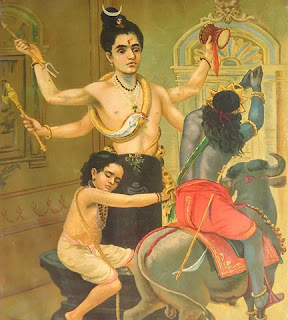SEVEN CHEERANJEEVI IN OUR UNIVERSE
The name is a mix of chiram ('permanent') and jīvi ('living'). It is comparable to amaratva, which means true immortality. At the end of the previous Manvantara, a demon attempted to become immortal by swallowing the sacred pages of the Vedas, which had escaped Brahma's lips. The first avatar (Matsya) of Vishnu rescued the scripture. Vishnu incarnations (Narasimha and Ram) later fought and destroyed two asuras, Hiranyakasipu and Ravana, who attempted to become immortal by offering obeisance to Brahma and Shiva. In one interpretation, immortal can mean "to live eternally until the destruction of universes", i.e., all physical bodies, along with the Brahma himself, are promised to become immaterial at the end of time.
Cultural significance: Widely celebrated in Kerala during Onam festival, symbolizing the return of prosperity and righteousness.
Cultural significance: Revered as a powerful warrior and upholder of dharma, his stories inspire upholding justice.
Origin story: Compiled the Mahabharata and other sacred texts. Conidered the son of Parashara and Satyavati.
Contributions :Preserved and transmitted vast knowledge through his writings.
Cultural significance: Revered as the author of the Mahabharata and other important texts, his work continues to shape Hindu culture and thought.
ATTRIBUTES
The surviving Puranas, the Ramyana, and the Mahabharata describe seven long-lived Hindu deities. There are other shlokas that are not included in this one. Each represents a unique aspect of humanity that will exist as long as they live.
Indian mythology, which is rich in stories about gods and civilization, captivates people because it is so prevalent. Gods transcend death, providing comfort and security. However, the seven eternal Chiranjeevis, or Chiranjeevi deities, are thought to live among people. This article looks into their stories, significance, and tremendous influence on Hindu culture, emphasizing the role of these deities in our perception of the divine.
The Tale of 7 Immortals Who are Still Alive
The term "7 chiranjeevi names" refers to seven specific immortals, each with unique characteristics and a distinct significance in Hindu mythology. We can acquire a better understanding of the lasting impact they have left behind.Throughout history, these Chiranjeevis have inspired innumerable people, providing wisdom, protection, and guidance.Their immortality demonstrates Hindu mythology's enduring force and importance in today's world.
1. Ashwatthama:
Origin story: Son of Drona, a warrior and teacher in the Mahabharata. Cursed with immortality and eternal pain by Krishna for attempting to kill a sleeping Pandava.
Key characteristics: Wrathful, vengeful, burdened by immortality.
Contributions: None, symbolizes the consequences of unchecked anger and the pitfalls of immortality without purpose.
Symbolic interpretation: Represents the destructive power of anger and the importance of finding meaning in life.
Cultural significance: Viewed as a tragic figure, a cautionary tale against vengeance and uncontrolled emotions.
2. Mahabali:
Origin story: King of the Asuras, known for his generosity and humility. Tricked into surrendering his kingdom by Lord Vishnu in his Vamana avatar.
Key characteristics: Generous, humble, virtuous.
Contributions: Established a prosperous kingdom, remembered for his good deeds.
Symbolic interpretation: Represents the power of humility, good deeds, and the cyclical nature of life.
Cultural significance: Widely celebrated in Kerala during Onam festival, symbolizing the return of prosperity and righteousness.
3. Kripacharya:
Origin story: Royal guru of the Pandavas and Kauravas in the Mahabharata. Lived for centuries, witnessing multiple generations.
Key characteristics: Wise, knowledgeable, impartial observer.
Contributions: Guided generations of warriors, offered wisdom and counsel.
Symbolic interpretation: Represents knowledge, guidance, and observing the unfolding of dharma (righteousness).
Cultural significance: Revered as a teacher and wise sage, his teachings continue to be valued.
4. Hanuman:
Origin story: Powerful vanara (monkey god) devotee of Lord Rama. Possesses immense strength and unwavering loyalty.
Key characteristics: Devout, courageous, strong, selfless.
Contributions: Played a crucial role in Rama's victory over Ravana, embodies ideal devotion and service.
Symbolic interpretation: Represents strength, faith, loyalty, and selfless service.
Cultural significance: One of the most beloved deities in Hinduism, worshipped for his devotion and strength.
5. Maharishi Markandeya:
Origin story: Sage who witnessed the destruction and recreation of the universe countless times. Received the boon of eternal youth from Lord Shiva.
Key characteristics: Wise, patient, observer of cosmic cycles.
Contributions: His wisdom and knowledge passed down through generations.
Symbolic interpretation: Represents the cyclical nature of existence, perseverance, and witnessing the grand unfolding of the universe.
Cultural significance: His story signifies the power of devotion and perseverance, offering hope for overcoming challenges.
6. Parashurama:
Origin story: Sixth avatar of Lord Vishnu, known for his warrior prowess and dedication to eliminating Kshatriya warriors who misused their power.
Key characteristics: Fierce warrior, upholder of dharma, advocate for justice.
Contributions: Eliminated corrupt rulers, established new dynasties based on righteous rule.
Symbolic interpretation: Represents the fight gainst injustice, the cyclical nature of good and evil, and the transformative power of time.
Cultural significance: Revered as a powerful warrior and upholder of dharma, his stories inspire upholding justice.
7. Veda Vyasa:
Origin story: Compiled the Mahabharata and other sacred texts. Conidered the son of Parashara and Satyavati.
Key characteristics: Wise, knowledgeable, chronicler of history.
Contributions :Preserved and transmitted vast knowledge through his writings.
Symbolic interpretation: Represents the power of knowledge, wisdom, and preserving history for future generations.
Cultural significance: Revered as the author of the Mahabharata and other important texts, his work continues to shape Hindu culture and thought.











Comments
Post a Comment